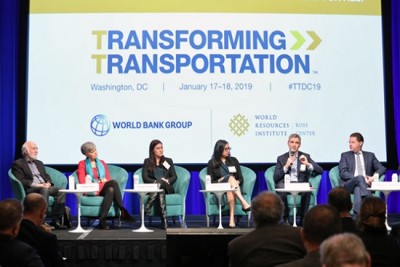How Should We Finance New Mobility?

In Brief
The private sector is leading the investment in new mobility; more public-sector participation is needed.
Local context matters; for example, financing new technologies in emerging markets requires a different model than financing them elsewhere does.
It is crucial to ensure that new mobility will benefit everyone in society.
At Transforming Transportation 2019, more than 1,100 participants joined World Bank Group and World Resources Institute (WRI) to discuss strategies to make new mobility more sustainable and affordable for everyone. On Jan. 17, experts from the financial sector talked about how to finance new mobility efficiently.
So how do we define new mobility? There is no right answer. New mobility usually requires multimodal transportation systems that are connected, smart and efficient. There are some examples around us – bike-rental programs, taxi-service providers, and electric-scooter transit.
Investment in the Public and Private Sectors
The panel started with a discussion of private- and public-sector investment in mobility. Nripesh Kumar, transport and infrastructure partner at EY, said there is plenty of investment from the private sector in transportation already.
“Mobility is a number of things. It’s shared, electric and connected,” Kumar said. “Private sector is taking the lead [in investment] – but are governments… really ready?”
Kumar pointed out that government revenue streams will change if they encourage electric vehicles and shared mobility services. This could lead to a significant drop in revenue from fuel taxes as people consume less diesel and petroleum.
Ziad Hayek, secretary general of high council for privatisation and PPP of Lebanon, also agreed that government usually is missing and commercial financing is dominant in mobility.
What about crowdfunding for mobility?
“I don’t see crowdfunding playing a major role, especially in emerging markets,” Hayek said. He said that the value-add of new mobility is uncertain and justifying the benefits to taxpayers is challenging.
Looking forward, Kumar said that mobility is more about providing services than creating assets. The efficient use of these assets, combining with real-time transportation information, will determine the future financial structure of new mobility.
New Mobility in Emerging Markets
In addition to looking at different sources of finance, the panel also focused on mobility in emerging markets.
Lisa Conibear, business manager of Shell Foundation, highlighted the intersection between new mobility and existing transport. She said that one example is in sub-Saharan Africa, where privatized transport is prevalent – including minibuses, and motorcycles.
“Local and foreign entrepreneurs are coming up with solutions using the technologies from new mobility that are pioneered by Uber and Lyft, for example, and using those to connect people that were previously not connected.” Conibear said.
Local context matters. Sometimes, new mobility might even fail. Surya Bagchi, global head of project and export finance at Standard Chartered Bank, also called attention to the failure of bike-sharing in many developing countries. The factors include unregulated competition, irresponsible usage, and excessive competitors.
This means that new mobility does not mean merely replacing existing modes of transport. Rather, creative solutions are needed to better connect people and increase the usage of existing transport systems in developing countries.
Bagchi also said that the scale of mobility will transform in emerging markets. This could have significant impact on new mobility financing.
“Emerging markets are facing some basic challenges,” Bagchi said. Technological changes - such as mobile banking, and distributed generation – are drivers for development. These technologies contribute to leapfrogging but also complicate the way new mobility is financed.
Financing new technology in emerging markets is not easy, especially during their early stages. Bagchi gave the example of solar PV in developing countries, where the affordability issue of solar PV made it difficult to finance these projects commercially already in 2009.
So how do these technologies spread in emerging markets?
“The answer is that there needs to be public and private solutions acting together so that the right social cost and benefit is applied through the public intervention and the private sector also finances it in partnership,” Bagchi said. After the technology is commercially viable, the private sector takes over and intervention is no longer needed.
Similarly, Conibear pointed out that most funding in sub-Saharan Africa is from foreign VC funders. They are more interested in business growth instead of its social impact. The challenge is to bring the appropriate amount of public and VC funding together so the company can grow while maximizing social impact.
New Mobility for All
The panel also discussed another important question: what does new mobility for all mean?
The goal of new mobility is to make transportation greener and more efficient. But it is equally important to ensure new mobility is accessible and affordable for rural and disabled populations – as well as for people who are low-income.
“We talked a lot about market solutions that address [the concerns of] people who can pay for this,” said Adriana Lobo, executive director of WRI México. “But the consequences for the very low-income people - not yet any improvement.”
Lobo emphasized the affordability issue by pointing out that even micro-mobility could be too expensive for low-income groups. Micro-mobility usually includes bicycles and scooters. It is crucial to introduce solutions that take everyone into consideration.
In addition to affordability, new mobility should improve travel safety for women. Conibear said that the potential benefits for women are significant but difficult to quantify. However, it is important to measure these positive externalities to bring more funders to the table.
Other panelists also commented on this topic and agreed that new mobility should contribute to the well-being of all members of the society. And this requires stable, long-term financing in new mobility from various players.
The panel discussion concluded with Bagchi’s remarks on public- and private-sector cooperation. “We do need this partnership [Public Private Partnership],” Bagchi said. “And we need this partnership across all sectors, not only new mobility or transport.”
To comment on this article, please post in our LinkedIn group, contact us on Twitter, or use our contact form.

